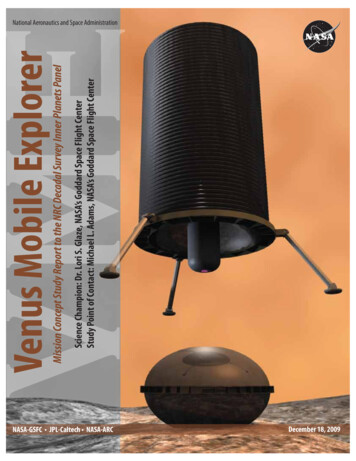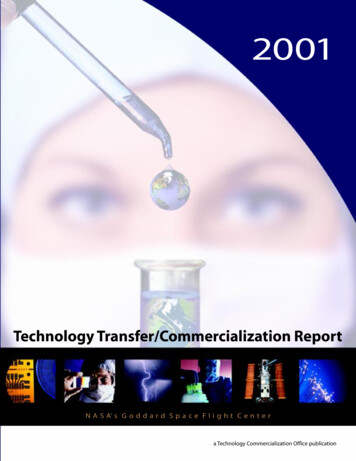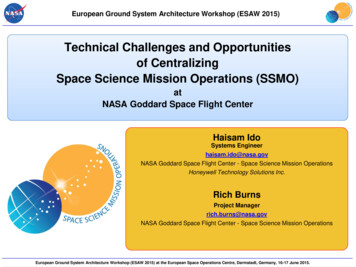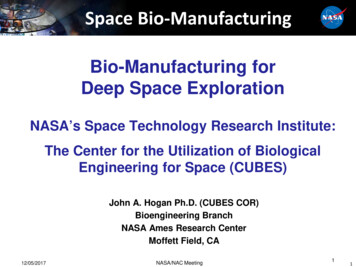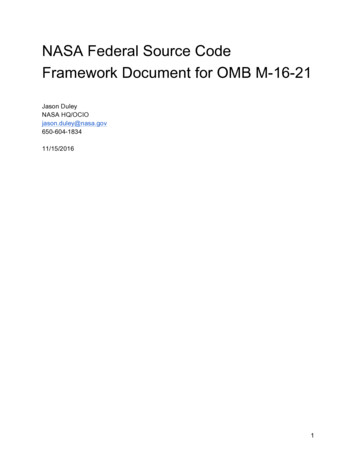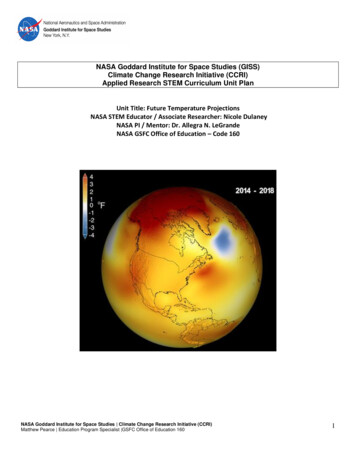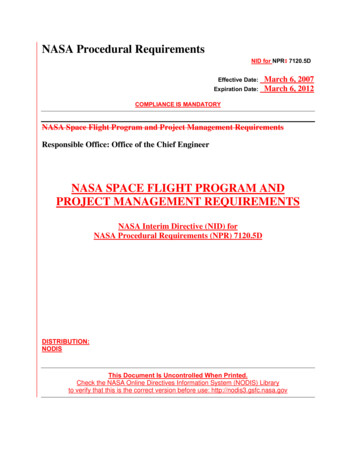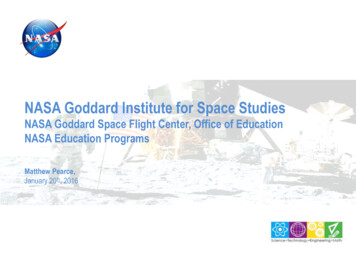
Transcription
NASA Goddard Institute for Space StudiesNASA Goddard Space Flight Center, Office of EducationNASA Education ProgramsMatthew Pearce,January 20th, 2016
NASA’s Education MissionOur mission is To advance high quality Science, Technology,Engineering, and Mathematics (STEM) educationusing NASA’s unique capabilitiesGoddard Institute for Space Studies2
NASA CentersGISS supports the New York tri-state area, but around the country, we’re located Goddard Institute for Space Studies3
Goddard CampusesFour campuses with one located on Columbia University’s campus here in New York CityIndependentVerification &ValidationWest VirginiaGoddardInstitute forSpace StudiesNew YorkGoddard Institute for Space StudiesWallopsVirginiaGoddard SpaceFlight CenterMaryland4
NASA Education Implementation FrameworkFramework embraces four key stages: inspire, engage, educate & employGoddard Institute for Space Studies5
NASA Education Office’s Four Lines of BusinessTo advance high quality Science, Technology, Engineering, and Mathematics (STEM) educationusing NASA’s unique capabilitiesNASA Internships, Fellowships andScholarshipsSTEM EngagementProviding opportunities for participatory and experiential learning activitiesthat connect learners to NASA-unique resources.Providing NASA work experiences and research opportunities to improveretention in STEM and prepare students for employment in NASA andSTEM industryNASA Office of EducationFour Lines of BusinessEducator Professional DevelopmentInstitutional EngagementPreparing STEM educators and leaders to deliver quality STEM instructionusing NASA-unique content.Improving the capacity of U.S. institutions to deliver effective STEMeducation and conduct NASA mission-related research. An overarchingoperating principle consistent throughout NASA's portfolio is a focus onmaking opportunities available to a diverse audience of educators andlearners, including women, minorities, and persons with disabilities.Goddard Institute for Space Studies6
STEM EngagementSTEM Engagement (SE) activities are designed to provide opportunities for participatoryand experiential learning activities that connect learners to NASA-unique resources.Public EducationActivitiesfoster interactions withlearners of all ages to sparkan interest in STEMdisciplines using NASAunique materials andresourcesExperiential LearningOpportunitiesenable learners to acquireknowledge, understandwhat they have learned,and apply that knowledgethrough inquiry-based andproject-based activitiesSTEM Challengesprovide creativeapplications of NASArelated science,technology, engineering,mathematics, and crosscutting conceptsSTEM Engagement activities are based on best practices in motivation, engagement, andlearning in formal and informal settings.Goddard Institute for Space Studies7
Educator Professional DevelopmentEPD uses NASA’s missions, education resources, and unique facilities to provide high-quality STEMcontent and hands-on learning experiences to in-service, pre- service and informal educators. In-service Educators: Include those currently practicing in a formal school system.Pre-service Educators: Have declared an education major or are graduates who have not yet completedtraining and certification to teach in a formal setting.Informal Educators: Provide organized educational activities outside of established formal school system.Face to Face Institute:F2F interaction at a NASA facilityconducted through a single deliverymodel implemented uniformlyacross all NASA Centers/Facilitieswhile leveraging content specific toeach Center/facility, at gradeappropriate levels based onspecific audiences, for a minimumof 40 contact hours.Partner-Delivered EPD:Partner-Delivered EPD provides auniform set of standards for partnersto adhere to when developing oroffering EPD in concert with NASA.Online EPD:Online EPD provides a uniform setof standards for designing, planningand implementing online learningopportunities for educators thatencompass a wide range oftechnologies and approaches thatallow participants to go beyondlimitations imposed by real- time,in-person EPD.Community-RequestedEPD:Community-Requested EPDprovides NASA Centers/JPLappropriate levels of flexibility tomeet and respond to the educatorprofessional development needsof their surrounding communitieson a case-by-case basis.Our efforts help establish linkages between formal and informal education, and encourage informaleducators who teach STEM subjects through exposure to and knowledge of NASA-related content.Goddard Institute for Space Studies8
Institutional EngagementNASA Institutional Engagement builds the capacity of formal and informal education institutionsto participate in NASA’s mission. IE: Improves their capabilities to gain support from external sources; fosters interactions between NASA Centers,academic institutions, and industry.Supports colleges and universities by helping them gain access to cutting-edge engineering and science facilitiesand personnel.Enables informal institutions, to engage their visitors through exhibits and displays that showcase NASA’sdynamic content.Supports the advancement and development of STEM personnel, programs, and infrastructure to enable formaland informal institutions to conduct NASA-related research and/or deliver NASA-related STEM content.Ins%tu%onal Engagement Seeks To:Build CapacityEncourage Networks & CommunitiesSustain CapacityGoddard Institute for Space StudiesEnsure Institutional DiversityDeliver Content9
NASA Internships, Fellowships and ScholarshipsNASA Internships, Fellowships, and Scholarships (NIFS) leverage NASA’sunique missions and programs to enhance and increase the capability,diversity, and size of the Nation’s future STEM workforce. NASA Internships are competitive awards to support educational workopportunities that provide unique NASA-related experiences foreducators and high school, undergraduate, and graduate students.NASA Fellowships are designed to support research, or senior designprojects by highly qualified faculty, undergraduate, and graduatestudents, in disciplines needed to help advance NASA’s missions.InternshipsFellowshipsScholarshipsNASA Scholarships provide financial support to undergraduate andgraduate students for studies in STEM disciplines to inspire and supportthe next generation of STEM professionals.Goddard Institute for Space Studies10
Goddard Institute for Space StudiesNASA GISS conducts theoretical and experimental research on the causes and consequencesof long-term global change, with an emphasis on education and outreach"Remote sensing ofAerosols and CloudsPlanetary ClimatesThe program includes climatemodeling, climate impacts, remotesensing of climate system featuressuch as aerosols and clouds, andcomparative planetary climatesGlobal Climate ModelingClimate ImpactsGoddard Institute for Space Studies11
NASA GISS Climate Change Research Initiative (CCRI)The NASA GISS Climate Change Research Initiative is a STEM education program that strategically integrates the strategiesand resources of the NASA Office of Educations four lines of business inclusive of NIF’s, STEM Engagement, EducatorProfessional Development and Institutional Engagement to provide significant impact and discovery to the research associatedwith the science and topics related climate change.Goddard Institute for Space Studies12
NASA GISS Climate Change Research Initiative:High School & Undergraduate InternsCCRI high school, graduate and undergraduate interns will conduct research, gain knowledge inassigned research discipline, and develop and present scientific presentations summarizing theirresearch experienceSpecifically, interns will be expected to; Write a scientific research report explainingbasic ideas and experimental set-up of theproject as well as their contribution to thework Prepare and present a PowerPoint summaryof their research project to a panel of subjectmatter experts Prepare and present a scientific poster oftheir research project at the CUNY SummerSTEM Research SymposiumGoddard Institute for Space Studies13
NASA GISS Climate Change Research Initiative EducatorsCCRI STEM Educators will conduct research, develop research based learning units and assistNASA scientists with the mentoring of high school, graduate and undergraduate studentsSpecifically, Educators will be expected to; Create and Applied Research STEM Curriculum UnitPortfolio based on their year long research experienceintegrating NASA unique education resources, tools andcontent Integrate and implement unique NASA units into theirexisting STEM courses during the following academic year. Mentor and coach high school students in the components ofwriting a scientific research paper for publishing, team oralresearch reporting, power point design for scientificpresentations and scientific poster design and presentationfor local and national research audiences.Goddard Institute for Space Studies14
CCRI Program DeliverablesPoster example:Evaluation of RM3Weather Forecastsover Western AfricaGoddard Institute for Space Studies15
NASA GISS Internship Education Summer Program:High School, Undergraduate, Graduate InternsHigh school, graduate and undergraduate interns will conduct research, gain knowledge inassigned research discipline, and develop and present scientific presentations summarizing theirresearch experienceSpecifically, interns will be expected to: Write a scientific research report explainingbasic ideas and experimental set-up of theproject as well as their contribution to thework Prepare and present a PowerPointsummary of their research project to apanel of subject matter experts Prepare and present a scientific poster oftheir research project at the CUNYSummer STEM Research SymposiumGoddard Institute for Space Studies Contact: Matthew Pearce Submit a research abstract Indicate types of interns desired Indicate desired background andskill set required. Register in OSSI16
NASA GISS Climate Change Research Initiative PosterA Study of Blue Carbon in Jamaica Bay 2015Dr. Dorothy Peteet , Stephen Kovari, Mohammad Reza, Stephanie SternPhoto%of%%Boat)Tail%Grackle% %Stephen%Kovari%taken%at%%Jamaica%Bay%NY%2014%Blue Carbon Project 2015NASA/Goddard Institute of Space Studies, Lamont Doherty Earth Observatory, New York City Research InitiativeAbstractHistoric Maps1780Library of Congress18491863Google Earth 2015IntroductionWetlands play a major role in climate stability as they processand sequester large amounts of carbon. However, the quantityof carbon storage depends on the rate of production/decomposition and the environmental stresses placed upon it.The salt marshes are an integral part of the global carboncycle. Recent studies of Jamaica Bay marshes indicate thatthere are a number of stressors that include waste treatmentplants, deep dredging and sea level rise. Deep dredges in thebay called “borrow pits” have created artificial depositionalbasins. Our work focused on the amount of organic andinorganic material in sediment cores from which we areawaiting C-14 AMS dates to calculate blue carbonsequestration through time.20151948ConclusionsCarbon’s Role in the WetlandsMethodologyStep 3: Analyze the datato determine organic andinorganic g/cm3 withLoss on Ignition (LOI) depth.Samples were taken at 4 cm increments from the core, dried for24 hours at 100 C, and burned at 500 C for 2 hours.Step 1: Sub-samplecores at 4cmincrements.LOI Source: NOAA1768Harvard Geospatial LibraryResults from Yellow Bar, JoCo andEast High Meadow MarshHarvard Geospatial LibraryHow have the organic/inorganic composition of Jamaica Bay Marshes beenchanging through time; and what drives these changes? What is rate of bluecarbon storage through time?Historic Charts NOAACarbon that is sequestered in coastal ecosystems and intertidalmarshes is known as “blue carbon.” We investigated andanalyzed sediment cores of three marshes in the HudsonEstuary to determine the amount of organic matter and carbonsequestered within them. Maps of Jamaica Bay from 250 yearsto the present are used to determine why there is a shift inorganic matter and a decline in inorganic matter within the lastestimated 300 years. We uncovered two possible impacts: i)the growth of Rockaway Spit over the last 250 years haselongated it, limiting the flow of seawater and sand into thebay, and ii) deep dredging may have altered the water flow anddeposition of sediments within the bay itself.Library of CongressQuestionsStep 2: Dry andsample for LOI.Dry Weight – Burned WeightDry WeightStep 4. Pick macrofossils for AMS dates to calculate carbon g/m2/yrGoddard Institute for Space StudiesOver the past 250 to 300 years, the growth ofRockaway Spit has lessened the inundation of oceanwater into the bay, probably affecting the amount ofinorganic sediment carried in. This extension probablydiminished the amount of inorganic sediment we find inthe marsh peat. Dams on the streams entering the baymay have also limited sediment supply. The deepborrow pits created by dredging for the construction ofboth Floyd Bennett Field and Idlewild Airport (nowJohn F. Kennedy International Airport) serve as artificialanthropogenic sediment sinks. Macrofossils for AMSdating, x-ray florescence, and carbon and nitrogenisotopes will aid us in calculating the rate of shifts inblue carbon and inorganic sediment through time.AcknowledgmentsGoddard Space Flight CenterGISSNYCRI17
NASA GISS High School STEM ARE(STEM) Academic Research ExperienceAREP – Minimum Requirements: 16 years of age at the start of AREP, minimum 3.0 GPA, U.S. citizen.AREP – Placement Process: Applicants are accepted by the research experience program at their school andrecommended to participate by advisor. Students will be on-site for a minimum of three half-days per week while the school is insession. Length of placement will be a minimum of ten weeks.Deliverables: Research poster and participate in a center poster session at the end of the semester/academic yearGoddard Institute for Space Studies18
GLOBEThe (GLOBE) program is a worldwide hands-on, primary and secondary school-based scienceand education program. GLOBE's vision promotes and supports students, teachers andscientists to collaborate on inquiry-based investigations of the environment and the Earth systemworking in close partnership with NASA, NOAA and NSFGLOBE community consists of more than 66,000 GLOBE-trainedteachers representing over 24,000 schools around the world. In addition,over 10 million students have participated in GLOBE -- contributingmore than 100 million measurements .NASA / GISS and the Intrepid have partnered to provide teacherprofessional development in the NYCGoddard Institute for Space Studies19
BESTNASA/GISS and the Intrepid Sea Air and Space Museum havepartnered to provide educators with a multi-day training toimplement BEST and Intrepid STEM Curriculum into instruction forstudents grades K-9The engineering design process is a series of steps that engineers use tosolve problems. BEST activities are different because they provide no"recipe" . Students‘ must "imagine and plan" before they begin to buildand experiment.BEST activities include (partial list): Build & launch a Satellite to Orbit theMoon, Design a Lunar Buggy, Design & Launch a Crew ExplorationVehicle, Launch Your CEV, Build a Solar Oven, 3D Printing, HubbleExhibitGoddard Institute for Space Studies20
Excellence & Innovation through Collaborative PartnershipsGoddard Institute for Space Studies21
NEXT STEPS CCRI:Continue to develop and expand current program and support regional partners. Summer Internships:Contact Matthew Pearce ASAP if you would like to recruit an intern. Funding is TBD andnot guaranteed. Applications period closes March 1. Development of NASA GISS Education Portfolio across four lines of business:Purpose: Define resources, partners and program spectrum, request funding to supportprograms. Development of NASA GISS Education Council:Meet with GISS science and education community on a regular basis (monthly / bimonthly) to discuss education initiatives, programing, partner programs, resources,grants, needs, opportunities, etc.Goddard Institute for Space Studies22
NASA’s Education Web Resources NASA Wavelength: Resources for Educators NASA Education: Education Express and All NASA Education Programs rnships.htmlNASA Goddard Institute for Space Studies: station/lessonsInternships at Goddard: lSTEM Lessons From Space SQ0NASA For Students: http://www.txstate-epdc.netSearch NASA Education Resources: mlFree Online STEM EPD: ASA Goddard Office of Education: t.htmlGoddard Institute for Space Studies23
Support & PartnershipThank you for your time today!We look forward to partnering with you,and having you be a partof the NASA family “Every great advance in science has issuedfrom a new audacity of imagination.”– John DeweyGoddard Institute for Space Studies24
NASA’s Goddard Office of EducationPlease contact me at Matthew PearceEducation Program SpecialistNASA Goddard Institute for Space Studies (GISS)2880 Broadway, Office 568212-678-6038 (o)646-419-0144 (c)Matthew.D.Pearce@nasa.govGoddard Institute for Space Studies25
Online EPD: Online EPD provides a uniform set of standards for designing, planning and implementing online learning opportunities for educators that encompass a wide range of technologies and approaches that allow participants to go beyond limitations imposed by real- time, in-person EPD. Community-Requested EPD: Community-Requested EPD
